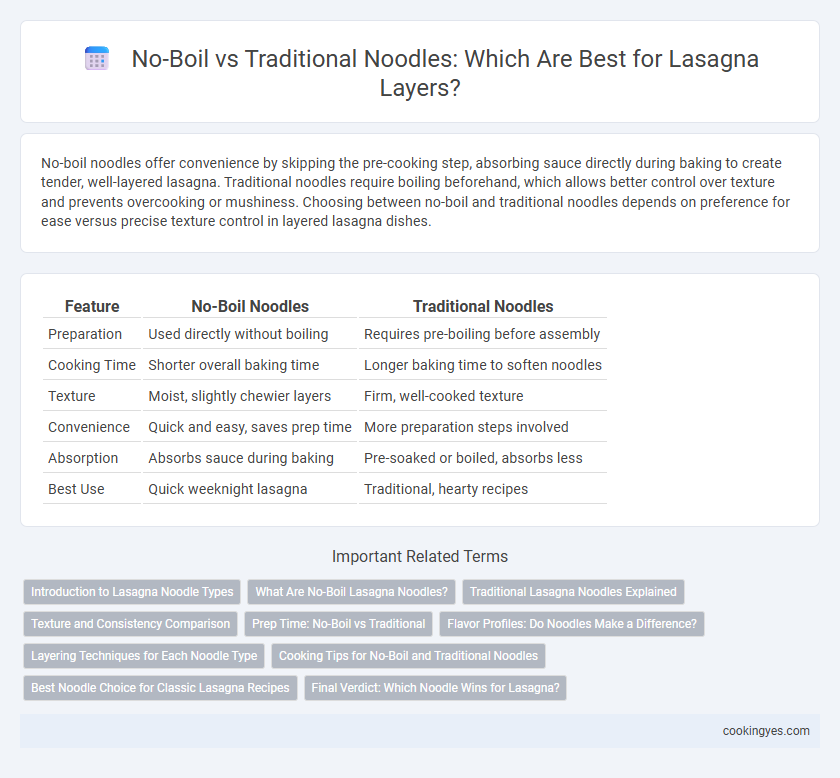No-boil noodles offer convenience by skipping the pre-cooking step, absorbing sauce directly during baking to create tender, well-layered lasagna. Traditional noodles require boiling beforehand, which allows better control over texture and prevents overcooking or mushiness. Choosing between no-boil and traditional noodles depends on preference for ease versus precise texture control in layered lasagna dishes.
Table of Comparison
| Feature | No-Boil Noodles | Traditional Noodles |
|---|---|---|
| Preparation | Used directly without boiling | Requires pre-boiling before assembly |
| Cooking Time | Shorter overall baking time | Longer baking time to soften noodles |
| Texture | Moist, slightly chewier layers | Firm, well-cooked texture |
| Convenience | Quick and easy, saves prep time | More preparation steps involved |
| Absorption | Absorbs sauce during baking | Pre-soaked or boiled, absorbs less |
| Best Use | Quick weeknight lasagna | Traditional, hearty recipes |
Introduction to Lasagna Noodle Types
No-boil noodles simplify lasagna preparation by absorbing sauce during baking, eliminating the need for pre-cooking, which reduces overall cooking time and effort. Traditional noodles require boiling before layering, ensuring a firmer texture and more control over noodle softness, which some chefs prefer for the classic lasagna structure. Choosing between these noodle types depends on desired texture, convenience, and recipe specificity, impacting the final dish's consistency and flavor integration.
What Are No-Boil Lasagna Noodles?
No-boil lasagna noodles are pre-cooked and dried pasta sheets designed to eliminate the boiling step before layering in lasagna. These noodles absorb moisture from the sauce and filling during baking, providing a tender texture without sacrificing structure. Choosing no-boil noodles simplifies preparation time and reduces the risk of overcooking or tearing traditional noodles.
Traditional Lasagna Noodles Explained
Traditional lasagna noodles are made from durum wheat semolina and require boiling before layering, ensuring a tender texture and proper absorption of sauce during baking. These noodles provide a firmer structure and classic mouthfeel, holding up well to rich, hearty fillings without becoming mushy. Their porous surface allows for better sauce retention, enhancing the overall flavor and consistency of baked lasagna.
Texture and Consistency Comparison
No-boil noodles for lasagna offer a softer, more tender texture as they absorb sauce directly during baking, preventing the risk of overcooking compared to traditional boiled noodles. Traditional noodles provide a firmer, slightly chewy bite and more defined layers, contributing to a structured and classic lasagna consistency. Choosing between no-boil and traditional noodles impacts the overall mouthfeel, with no-boil promoting a creamier, cohesive dish while traditional noodles maintain distinct textural contrasts.
Prep Time: No-Boil vs Traditional
No-boil noodles significantly reduce prep time by eliminating the need for pre-cooking, allowing direct layering in the lasagna assembly. Traditional noodles require boiling before layering, which adds approximately 10 to 15 minutes to the preparation process. This time-saving aspect makes no-boil noodles a preferred choice for quicker lasagna preparation without compromising texture.
Flavor Profiles: Do Noodles Make a Difference?
No-boil noodles absorb sauce more effectively, resulting in a softer texture that blends flavors seamlessly within lasagna layers. Traditional noodles offer a firmer bite and slightly toasted notes when pre-cooked, contributing to a layered texture contrast. The choice between no-boil and traditional noodles ultimately influences the overall mouthfeel and how flavors from the sauce and cheese meld throughout the dish.
Layering Techniques for Each Noodle Type
No-boil noodles simplify layering by requiring no pre-cooking, allowing direct assembly with sauce to soften during baking and maintain distinct layers. Traditional noodles demand pre-cooking to al dente, ensuring pliability for smooth, even layering that prevents breakage and uneven texture. Proper layering techniques for both noodle types influence lasagna's structural integrity and flavor absorption, optimizing the balance between sauce and pasta in each bite.
Cooking Tips for No-Boil and Traditional Noodles
No-boil noodles save time by softening during baking, requiring slightly more sauce to ensure even cooking and prevent dryness. Traditional noodles need pre-boiling until al dente to avoid mushiness, allowing precise control over texture but adding prep time. Both methods benefit from layering ample sauce to maintain moisture and achieving a well-cooked, tender lasagna.
Best Noodle Choice for Classic Lasagna Recipes
No-boil noodles offer convenience by eliminating the pre-cooking step while maintaining a tender texture in classic lasagna layers. Traditional noodles, when boiled properly, develop a slightly firmer bite and better absorb the tomato sauce, enhancing overall flavor depth. For authentic lasagna recipes, chefs often prefer traditional noodles to achieve the perfect balance of structure and sauce infusion.
Final Verdict: Which Noodle Wins for Lasagna?
No-boil noodles offer convenience and time savings without sacrificing texture, making them ideal for busy cooks who want tender layers with less prep. Traditional noodles deliver a firmer bite and richer flavor after pre-cooking, preferred by those seeking authentic, control-driven lasagna results. For the final verdict, no-boil noodles win for ease and efficiency, while traditional noodles triumph for culinary detail and nuanced texture.
No-Boil Noodles vs Traditional Noodles for Lasagna Layers Infographic

 cookingyes.com
cookingyes.com